Planify Feed
Date: Thu 25 Dec, 2025
Over the past year, several companies that were once part of the pre-IPO universe have successfully crossed the final milestone entry into the public markets.
Names like HDB Financial Services, Wakefit, Groww, Lenskart, Meesho, Studds Accessories, Tata Capital, LG Electronics India, PhysicsWallah, Pace Digitek, and Vikram Solar are no longer just private growth stories they are now publicly listed companies with real market discovery.
- What makes this transition noteworthy is not just the listings, but the timing and scale at which these companies entered the markets. Many of them listed amid tight liquidity conditions, higher scrutiny on valuations, and sharper investor expectations yet managed to attract demand and deliver meaningful listing outcomes.
- Performance across these listings was mixed, spanning strong debut gains, flat listings, and gradual post-listing upside.
For investors who accessed these names during the pre-IPO phase, the journey reflects something important:
Early conviction, when backed by strong business fundamentals and sector leadership, can translate into credible public-market performance.
Date: Tue 23 Dec, 2025
Financial Performance (Q2 FY26 vs Q1 FY25):Care Health Insurance reported a mixed financial performance in Q2 FY26, with total revenue growing by 6.5% to ₹1,961.6 crore, compared to ₹1,842.3 crore in Q1 FY25. Despite the top-line growth, profitability came under pressure. Profit After Tax (PAT) declined by 22.8% to ₹32.1 crore, compared to ₹41.56 crore in Q1 FY25. Consequently, Earnings Per Share (EPS) decreased by 23.3% to ₹0.33, from ₹0.43 in the reference period. The growth in revenue indicates continued business momentum, while the contraction in PAT suggests potential impacts from higher claims or operational costs during the quarter.
Operational Metrics (Q2 FY26): Operational performance highlights a significant scale of operations. The company reported a total policy count of 1,00,30,733 during the current year, indicating a massive customer base. Claims volume was also substantial, with 8,31,150 claims registered. Service efficiency remained a key strength; policy-level complaints stood at a low 0.81 per 10,000 policies, and claim-related complaints were 47 per 10,000 claims. The grievance redressal mechanism was highly effective, with 100% of the 254 pending complaints being less than 15 days old, ensuring zero backlog beyond the regulatory timeline.
Strategic Developments: The company continues to strengthen its market position with a focus on scaling its policy issuance and managing high claim volumes efficiently. The data reflects a strategic emphasis on customer service quality, evidenced by the low complaint ratios and swift grievance resolution. While specific capital initiatives for the quarter were not highlighted in this disclosure, the operational stability suggests a continued focus on long-term sustainability and trust-building within the health insurance sector. The disparity between revenue growth and profit decline may point to a strategic decision to absorb higher claim costs to maintain market share or service standards.
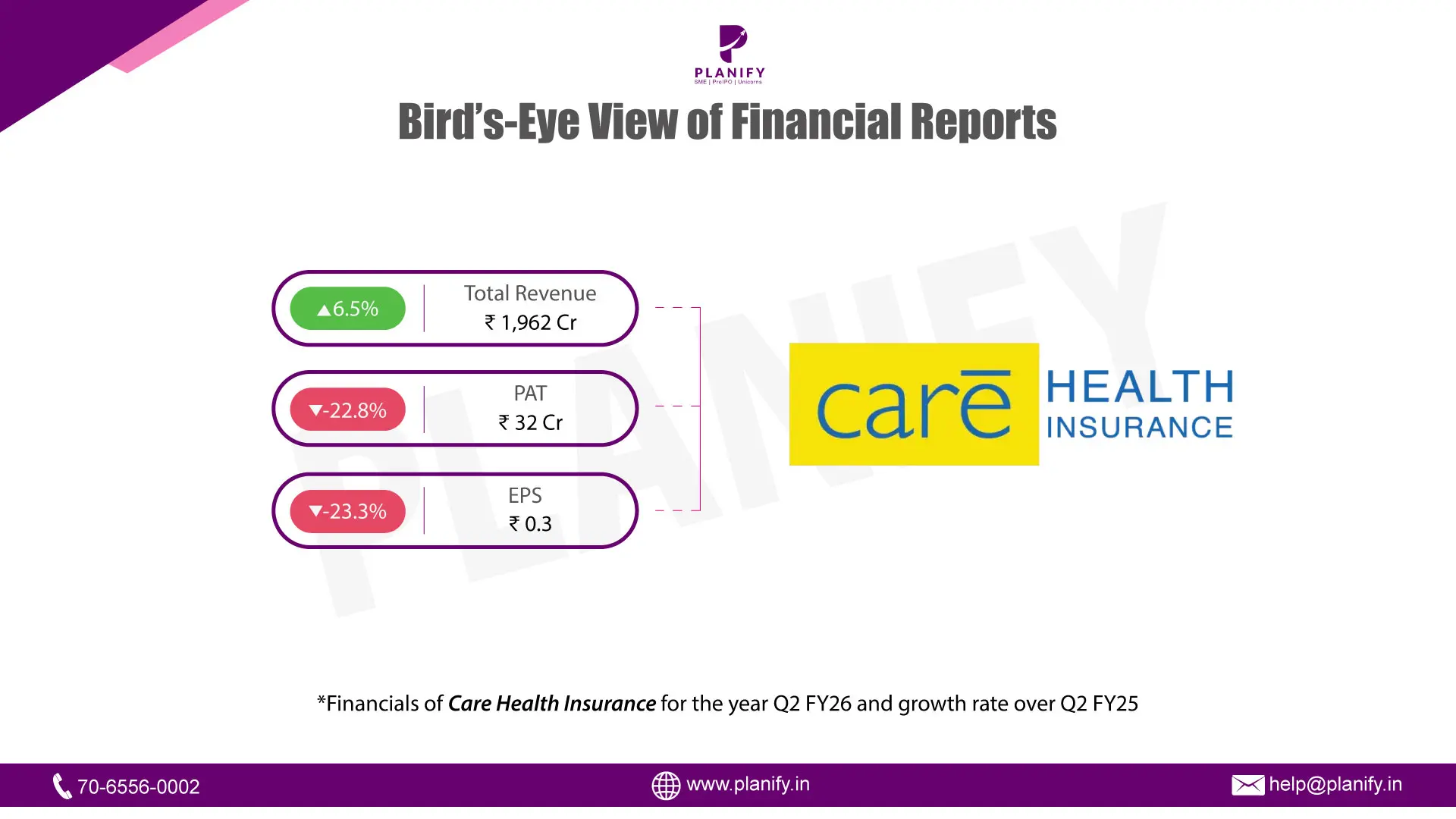
Date: Tue 23 Dec, 2025
Financial Performance (Q2 FY26 vs Q2 FY25): Motilal Oswal Financial Services Limited reported a weaker financial performance in Q2 FY26, with total revenue declining by 37.6% year-on-year (YoY) to ₹1,125 crore, compared to ₹1,803 crore in Q2 FY25. The decline was mainly due to a sharp reduction in brokerage and fees income along with a loss on fair value changes of ₹40 crore, compared to a gain of ₹443 crore in the same quarter last year. Profit After Tax (PAT) declined by 81.5% YoY to ₹127 crore, compared to ₹689 crore in the same quarter last year.
Operational Metrics (Q2 FY26 vs Q2 FY25):Operational performance saw pressure on margins during the quarter due to the volatility in fair value gains and lower revenue. Operating margin declined to 22.5% in Q2 FY26 from 43.1% in Q2 FY25, while net profit margin reduced to 17.8% from 33.2% last year. The interest service coverage ratio stood at 2.78 times for the half-year ended September 2025, slightly lower than 2.92 times in the previous corresponding period. The debt-to-equity ratio improved to 1.15 times from 1.22 times, while the debtors turnover ratio slowed to 0.87 times from 1.04 times, indicating changes in collection velocity.
Strategic Developments: During the quarter, the company raised ₹500 crore via private placement of Non-Convertible Debentures (NCDs) to strengthen its liability profile. The company also allotted 9,98,550 equity shares under employee stock option schemes, continuing its focus on employee retention. A significant positive development was the upgrade of the company's long-term credit rating by ICRA to AA+ (Stable) from AA (Positive) in October 2025. The company’s net worth increased to ₹7,804 crore, up from ₹6,939 crore in the previous period. Additionally, the company voluntarily disclosed PAT excluding unrealized mark-to-market gains, which stood at ₹283 crore for the quarter, to provide a clearer view of underlying operating performance.
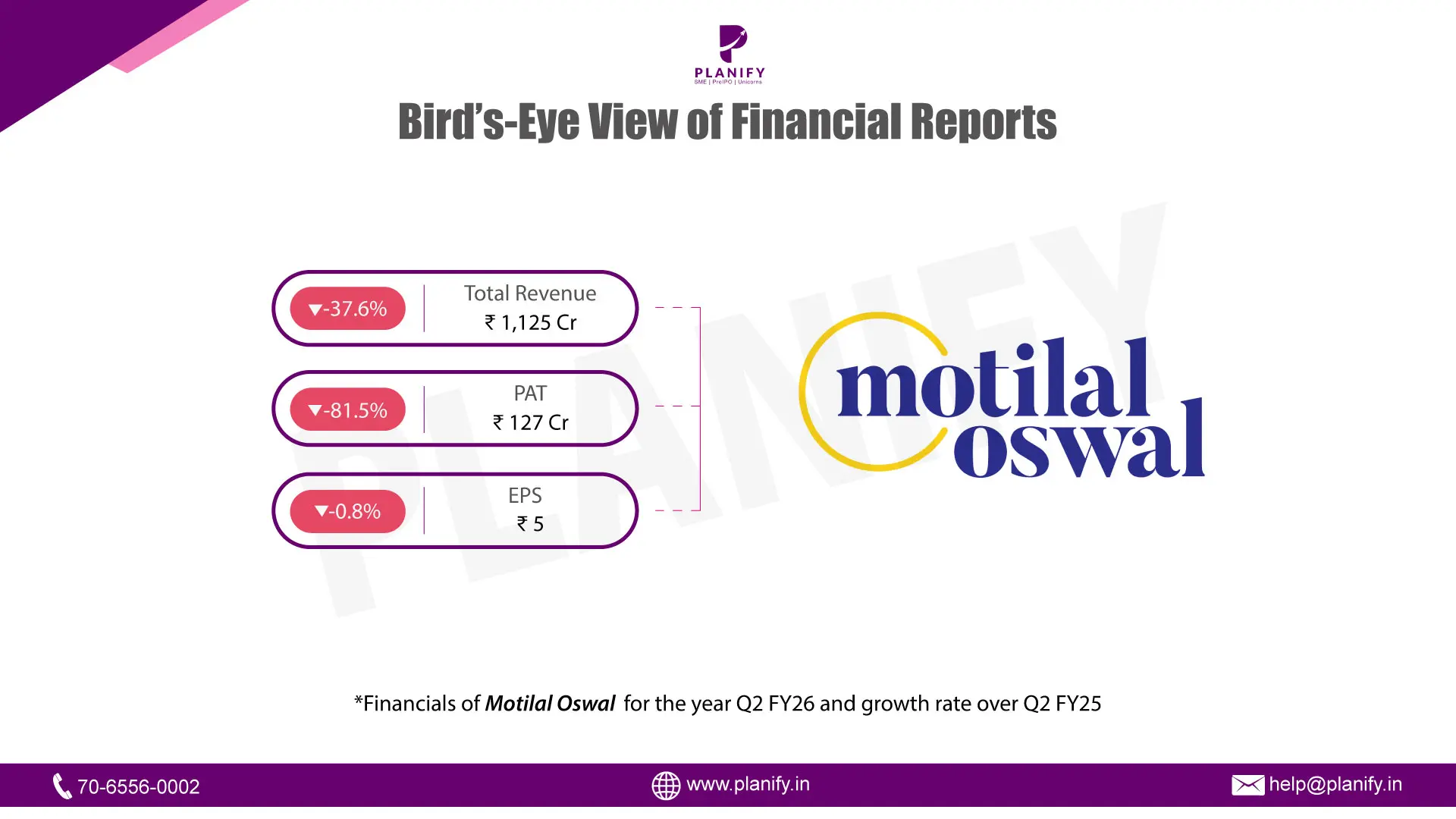
Date: Tue 23 Dec, 2025
Financial Performance (Q2 FY26 vs Q2 FY25):PPFAS reported a robust financial performance in Q2 FY26, with total revenue increasing by 23.4% year-on-year (YoY) to ₹143 crore, compared to ₹116 crore in Q2 FY25. The growth was primarily driven by an increase in fees and commission income from its asset management business. Profit Before Tax (PBT) rose significantly by 37.2% YoY to ₹123.8 crore from ₹90.2 crore in the same quarter last year. Profit After Tax (PAT) grew by 39.6% YoY to ₹92.7 crore, compared to ₹66.5 crore in Q2 FY25. Earnings Per Share (EPS) also saw a substantial increase, rising to ₹120.5, from ₹86.7 last year.
Operational Metrics (Q2 FY26 vs Q2 FY25):Operational performance demonstrated strong efficiency and margin expansion during the quarter. The net profit margin improved to 65.3% in Q2 FY26 from 57.3% in Q2 FY25, reflecting better cost leverage. Total expenses for the quarter stood at ₹19.2 crore, managed effectively against the rising revenue base. The company remains debt-free with only lease liabilities on the books, maintaining a robust balance sheet. The company’s consolidated net worth surged to ₹828.5 crore, up 55.4% YoY from ₹533.2 crore in September 2024, highlighting significant internal accruals and financial strength.
Strategic Developments: During the period, the company paid a final dividend of ₹11.54 crore for the previous financial year, underscoring its commitment to shareholder returns. A key accounting policy change was implemented, shifting the depreciation method for Property, Plant, and Equipment from Written Down Value (WDV) to the Straight Line Method (SLM) to align with group policies. The company continues to distinguish its "Core" operating performance by excluding unrealized mark-to-market gains on investments, which stood at ₹30 crore for the half-year, ensuring a transparent view of business health.
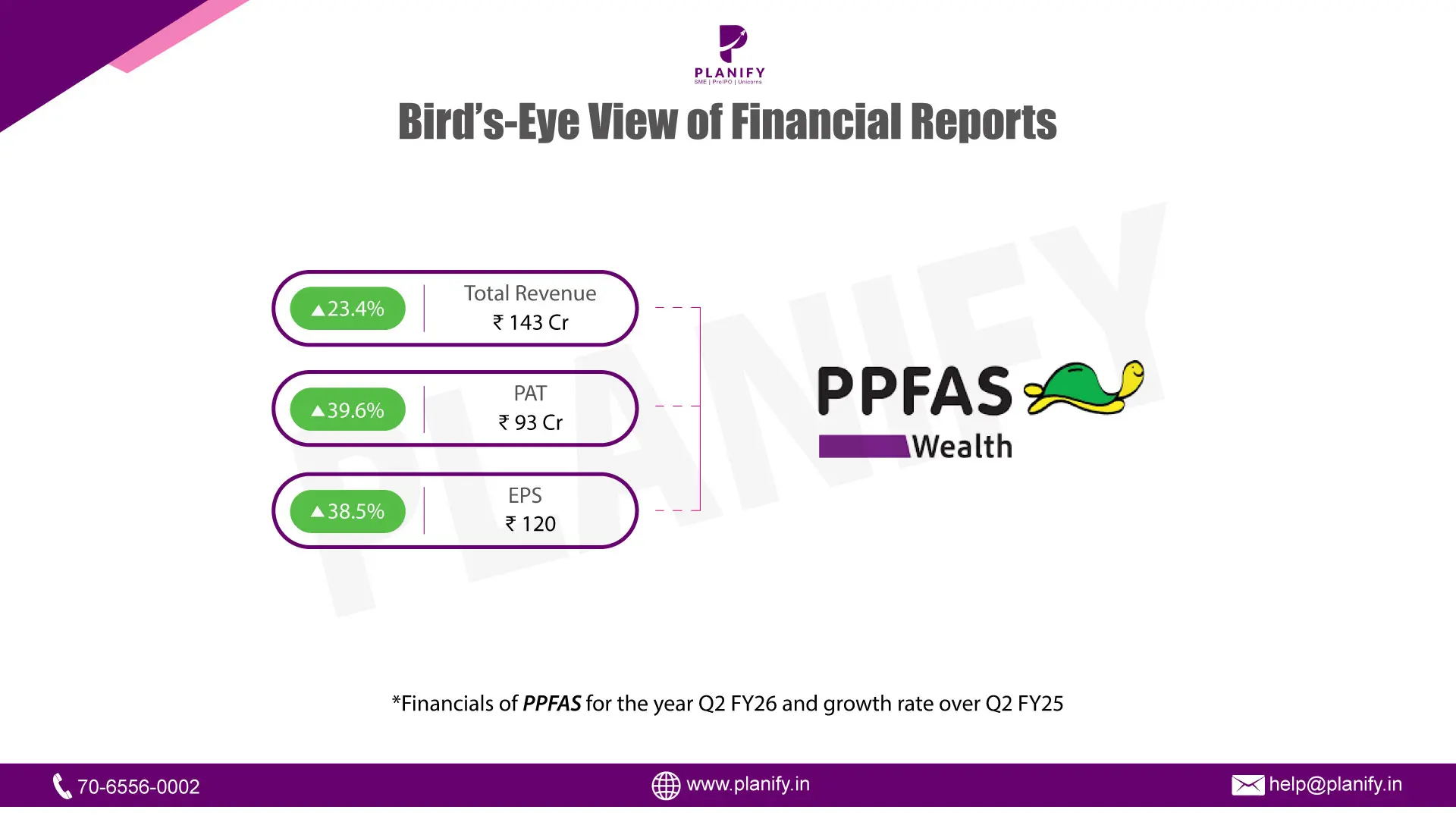
Date: Tue 23 Dec, 2025
Financial Performance (Q2 FY26 vs Q2 FY25): Acko General Insurance Ltd reported a marginally weaker topline performance in Q2 FY26, with revenue declining by 0.9% year-on-year (YoY) to ₹547.0 crore, compared to ₹552.0 crore in Q2 FY25. Despite the slight drop in revenue, profitability improved sharply during the quarter, with Profit After Tax (PAT) turning positive at ₹22.8 crore versus a loss of ₹86.1 crore in the same period last year, reflecting a 126.4% YoY improvement. Earnings Per Share (EPS) also improved significantly to ₹0.16 in Q2 FY26 from a negative ₹0.32 in Q2 FY25, marking a 150.0% YoY increase, indicating a strong turnaround in operating and underwriting performance.
Operational Metrics (Q2 FY26 vs Q2 FY25): Operational performance reflected better cost management and underwriting efficiency during the quarter. The solvency ratio stood at 2.29 times, well above the regulatory requirement, compared to 2.43 times in Q2 FY25. The net retention ratio remained stable at 76.17% compared to 74.83% in the previous year.
Strategic Developments: During the quarter, Acko continued its focus on product diversification, launching new retail and group health products such as Acko Health II and Acko 360 Protect. The company maintained a digital-first approach, with Direct Business (Online) contributing significantly to the total premium of ₹62,167 lakhs for the quarter. Despite higher claims reported in some segments, the claims settlement ratio remained a priority, and the reduction in management expenses to gross premium ratio (35.93% vs 52.63%) supports long-term sustainability.
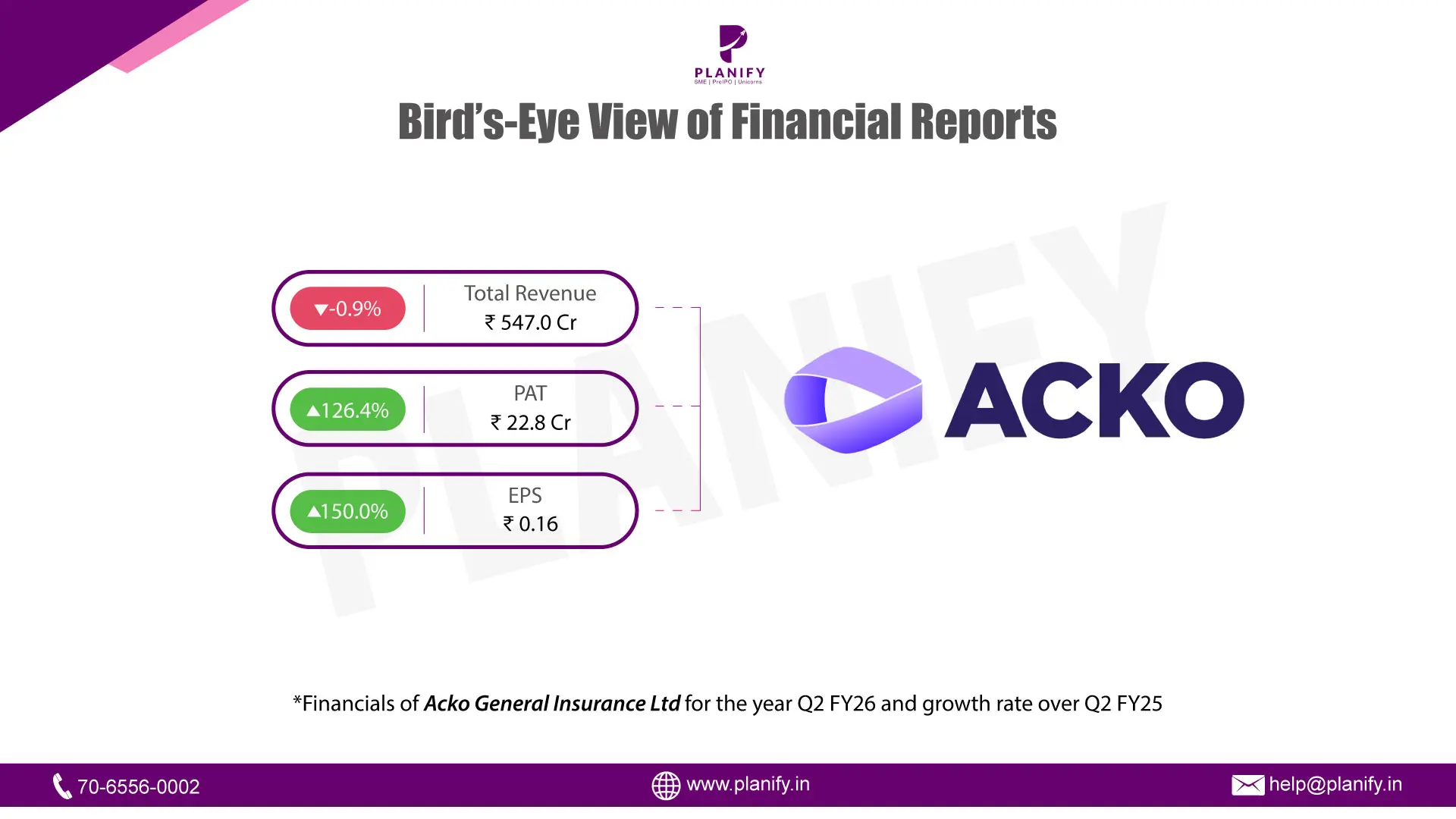
Date: Tue 23 Dec, 2025
Financial Performance (Q2 FY26 vs Q1 FY25): IndusInd General Insurance reported a moderated financial performance in Q2 FY26, with total revenue declining by 5.7% to ₹2,166 crore, compared to ₹2,296 crore in Q1 FY25. The dip suggests a slight contraction in top-line growth during the period. Profit After Tax (PAT) declined by 9.6% to ₹120.5 crore, compared to ₹133.36 crore in Q1 FY25. Consequently, Earnings Per Share (EPS) decreased by 10.3% to ₹4.51, from ₹5.03 in the previous period. The simultaneous decline in revenue and profitability points to potential pressures on premium collections or investment income, impacting the overall bottom line.
Operational Metrics (Q2 FY26): Operational performance highlights a substantial volume of business activities. The total number of policies issued during the current year stood at 49,70,736, indicating a very strong market presence. Claims activity was also significant, with 27,13,250 claims registered during the current year. Service efficiency metrics showed 1.16 policy-related complaints per 10,000 policies and 4.44 claim-related complaints per 10,000 claims. The grievance redressal mechanism appeared robust, with the majority of pending complaints (1,205) being less than 15 days old, reflecting a focus on timely resolution.
Strategic Developments: The company is operating under a new identity, having transitioned from Reliance General Insurance Company Limited to IndusInd General Insurance Company Limited. This rebranding likely marks a significant strategic pivot, possibly aligning with broader group objectives or ownership changes. The high volume of policies and claims underscores the company's continued operational scale despite the financial dip. While specific capital allocation details for this quarter were not highlighted in the snippets, the operational data suggests a continued emphasis on maintaining service levels and managing a vast customer base amidst the corporate transition.
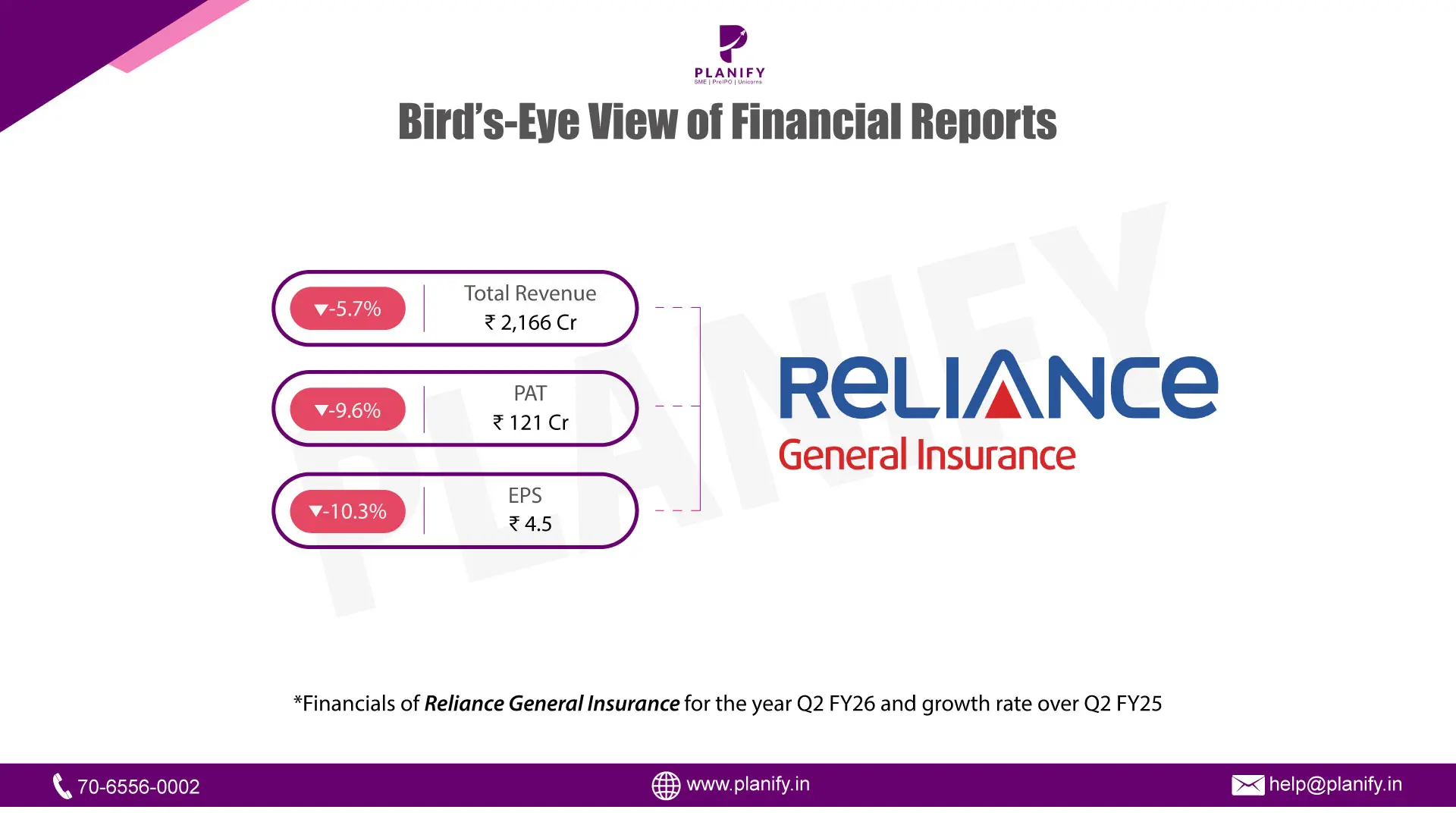
Date: Tue 23 Dec, 2025
Financial Performance (Q2 FY26 vs Q2 FY25): Axis Max Life Insurance Ltd reported a weaker financial performance in Q2 FY26, with total revenue declining by 25.8% year-on-year (YoY) to ₹9,946.4 crore, compared to ₹13,408.6 crore in Q2 FY25. The decline was primarily driven by lower premium income along with a sharp moderation in investment-related income during the quarter. Profit After Tax (PAT) declined by 15.7% YoY to ₹84.7 crore from ₹100.5 crore in the corresponding quarter last year. Earnings Per Share (EPS) also declined by 16.3% YoY to ₹0.41, compared to ₹0.49 in Q2 FY25.
Operational Metrics (Q2 FY26 vs Q2 FY25): In Q2 FY26, Axis Max Life Insurance recorded a stable net retention ratio of 97.8%, marginally lower than the 98.0% in Q2 FY25. The conservation ratio showed general improvement across several categories, with Non-Linked Participating Life rising to 84.3% from 83.0% and Non-Linked Non-Participating Life increasing to 88.2% from 86.2%. Total net benefits paid for the quarter increased to Rs. 483,374 lakhs in Q2 FY26, up from Rs. 420,463 lakhs in the previous year's second quarter.
Strategic Developments: During the quarter, the company faced a challenging operating environment marked by subdued insurance demand and volatile financial markets. Performance continued to be influenced by slower premium growth and lower investment income. While near-term results were impacted by operational and earnings pressure, the company’s established market presence and diversified product portfolio provide longer-term business stability.
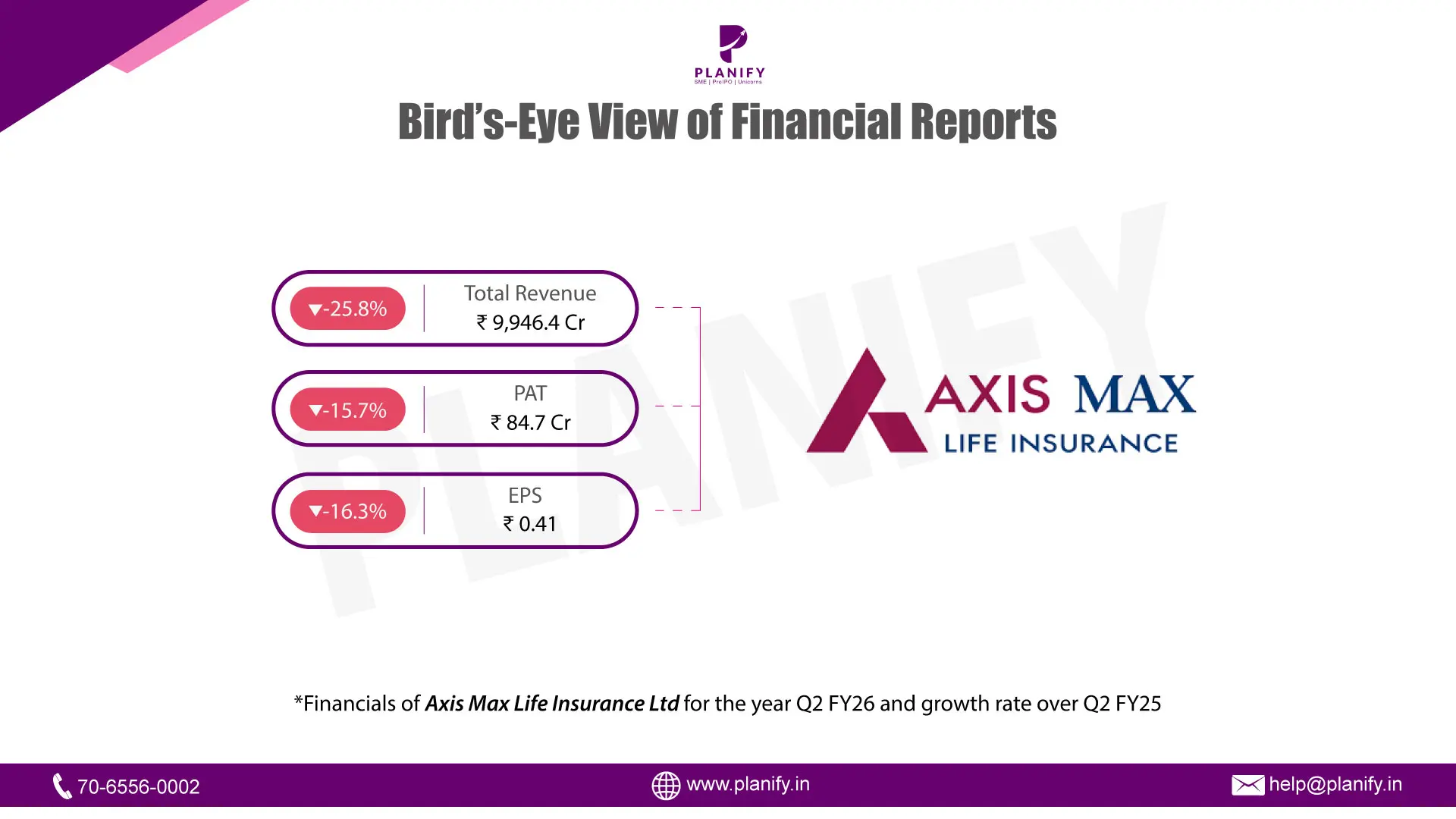
Date: Tue 23 Dec, 2025
Financial Performance (Q2 FY26 vs Q2 FY25): India First Life Insurance reported a weaker financial performance in Q2 FY26, with total revenue declining by 22.5% year-on-year (YoY) to ₹2,073.1 crore, compared to ₹2,673.8 crore in Q2 FY25. The decline reflects lower income generation during the quarter, likely impacted by moderation in premium inflows and investment-related income. Profit Before Tax (PBT) was lower during the quarter, translating into a decline in profitability. Profit After Tax (PAT) fell by 33.0% YoY to ₹15.3 crore from ₹22.8 crore in the same quarter last year. Earnings Per Share (EPS) declined by 33.3% YoY to ₹0.2, compared to ₹0.3 in Q2 FY25.
Operational Metrics (Q2 FY26 vs Q2 FY25): For the quarter ended September 30, 2025, India First Life Insurance reported total net benefits paid of Rs. 105,315.20 lakhs, representing an increase from the Rs. 83,366.32 lakhs paid in the corresponding quarter of the previous year. This total includes claims by death amounting to Rs. 19,295.82 lakhs (down from Rs. 19,524.71 lakhs in Q2 FY25) and a significant rise in claims by maturity, which reached Rs. 27,082.89 lakhs compared to Rs. 3,771.66 lakhs in Q2 FY25. Surrenders and withdrawals remained a major component of benefits at Rs. 58,049.26 lakhs, slightly up from Rs. 55,381.02 lakhs in the previous year.
Strategic Developments: During the quarter, the company continued to operate across both policyholders’ and shareholders’ accounts, maintaining focus on core life insurance offerings. While near-term performance was impacted by lower revenue and profitability, the company’s business remains supported by its diversified product mix and long-term insurance liabilities. Going forward, performance is expected to remain linked to premium growth trends, claims experience, and investment income performance.
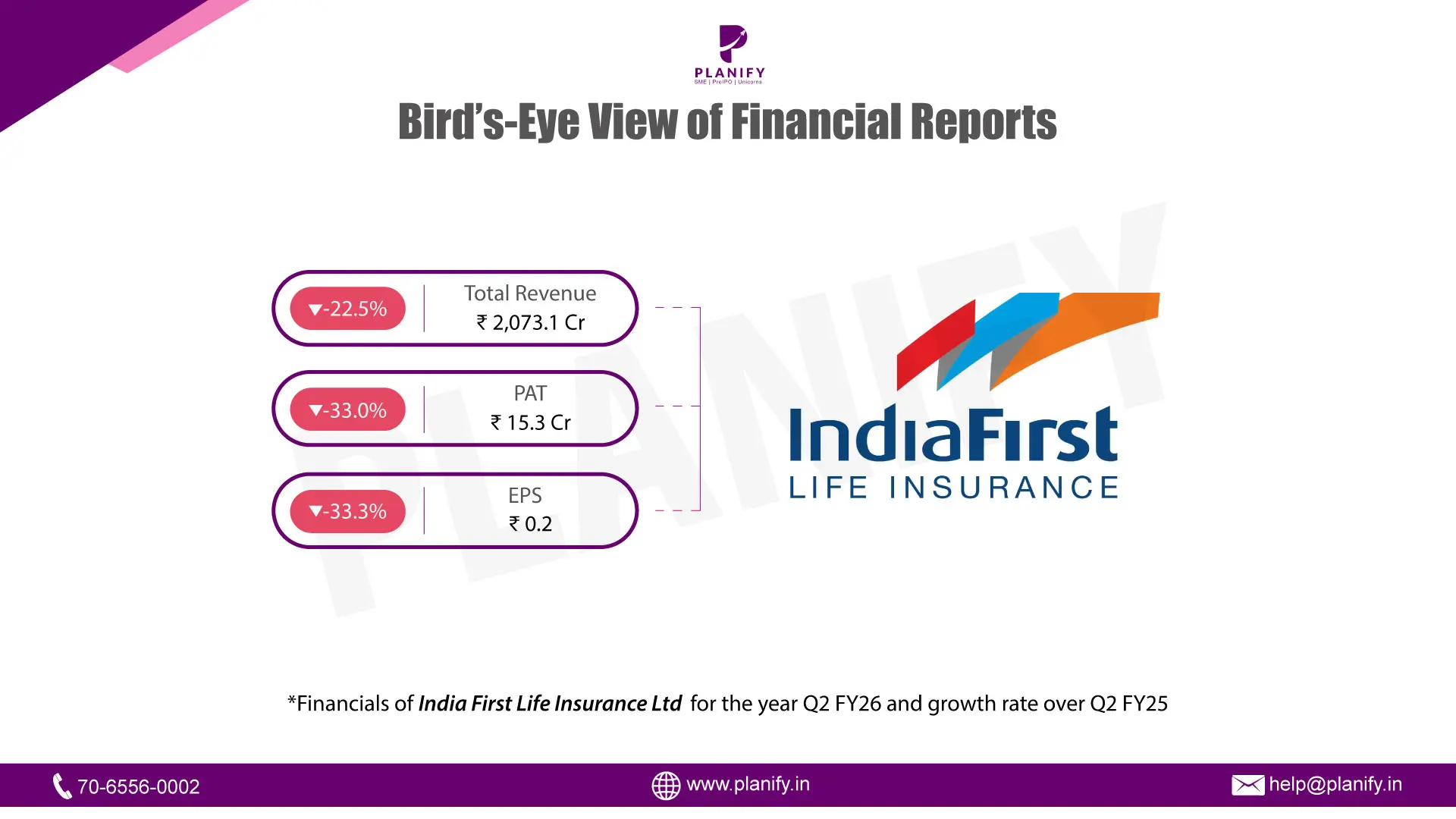
Date: Mon 22 Dec, 2025
Financial Performance (Q2 FY26 vs Q2 FY25): NCL Buildtek Ltd reported a mixed set of numbers for Q2 FY26. Revenue from Operations (Consolidated) increased by 12.2% year-on-year (YoY) to ₹10,852.52 lakh, compared to ₹9,673.59 lakh in Q2 FY25. However, despite the growth in topline, Profit After Tax (PAT) declined by 26.6% YoY to ₹234.64 lakh, down from ₹319.51 lakh in the same quarter last year. This drop occurred even though Profit Before Tax (PBT) (after exceptional items) rose to ₹333.14 lakh from ₹194.81 lakh in Q2 FY25. The decline in PAT was primarily driven by a significant tax expense of ₹98.50 lakh in the current quarter, compared to a tax credit adjustment in the previous year. Consequently, Earnings Per Share (EPS) (including exceptional items) fell to ₹1.22 from ₹5.47 in the corresponding period last year.
Operational Metrics (Q2 FY26 vs Q2 FY25): Operational performance varied significantly across business segments. The Coatings segment posted strong growth, with revenue rising to ₹2,560.97 lakh from ₹2,188.84 lakh last year, and segment profit nearly doubling to ₹341.56 lakh. The Windoors segment remained the largest contributor, with revenue increasing to ₹5,867.59 lakh from ₹4,863.83 lakh. However, margins remained tight; the consolidated Operating Margin stood at 5%, while the Net Profit Margin was recorded at 2% for the quarter. The Interest Coverage Ratio was reported at 1.56 times, reflecting the impact of finance costs, while the Debtors Turnover Ratio stood at 1.88 times.
Strategic Developments: During the quarter, the company recorded an exceptional item gain of ₹79.99 lakh, which supported the profit before tax figures. While the Windoors and Coatings divisions showed resilience and growth, the Walls segment faced headwinds, reporting a segment loss of ₹84.08 lakh compared to a minor loss of ₹0.98 lakh in Q2 FY25. The company’s consolidated Net Worth stood at ₹23,060.09 lakh as of September 30, 2025, maintaining a stable capital base despite the pressure on bottom-line profitability. The financial results were reviewed by the Audit Committee and approved by the Board of Directors on November 13, 2025.
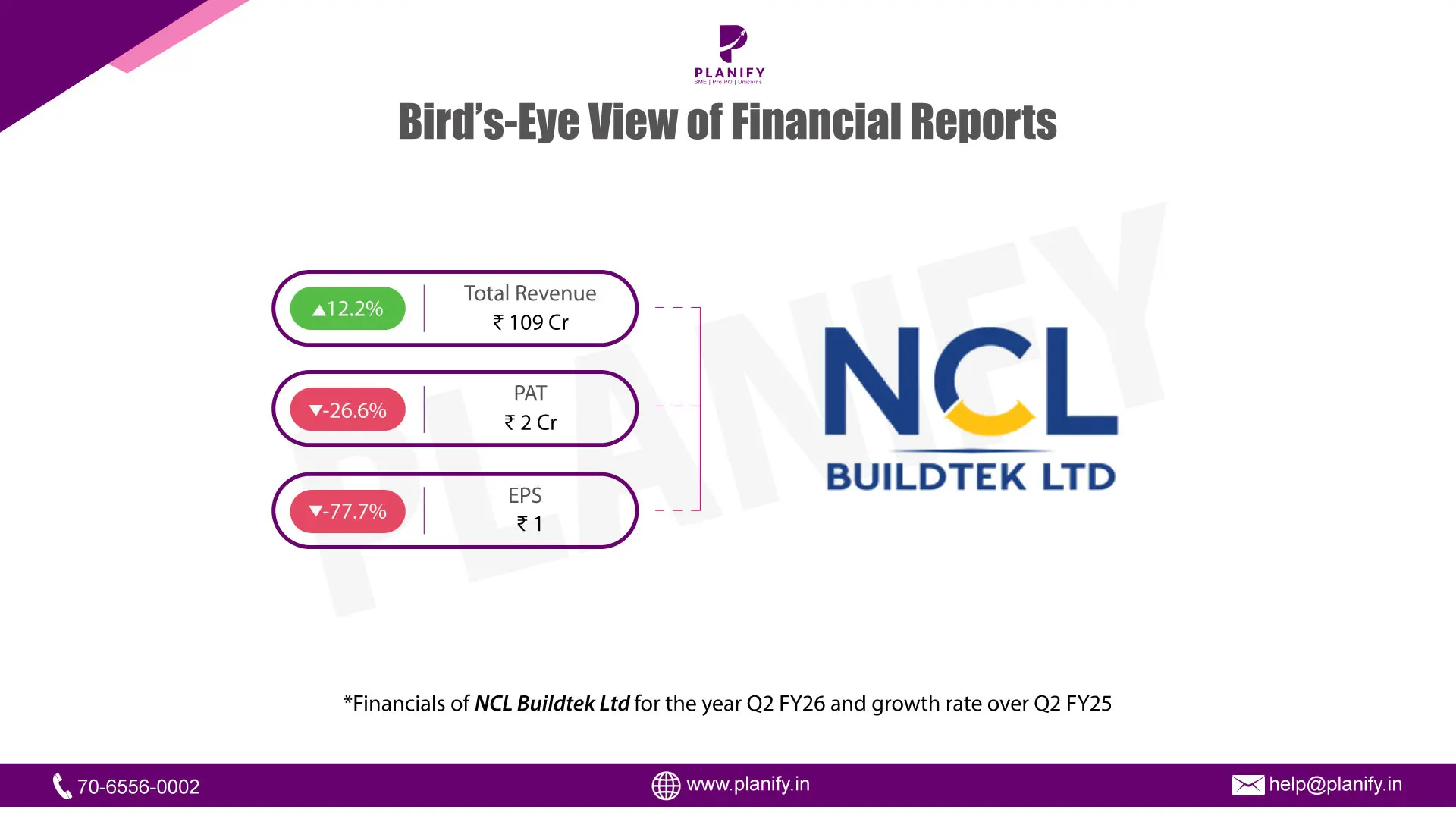
Date: Mon 22 Dec, 2025
Financial Performance (Q2 FY26 vs Q2 FY25): IKF Finance reported a strong financial performance in Q2 FY26, with total income increasing by 37.6% year-on-year (YoY) to ₹222.42 crore, compared to ₹161.62 crore in Q2 FY25. The growth was primarily driven by a sharp rise in interest income, which grew 39.4% YoY to ₹207.2 crore, supported by steady loan book expansion and stable yields. Profit Before Tax (PBT) rose by 31.8% YoY to ₹61.0 crore from ₹46.3 crore in the corresponding quarter last year, despite higher impairment charges. Profit After Tax (PAT) increased by 31.9% YoY to ₹45.5 crore, compared to ₹34.5 crore in Q2 FY25. Earnings Per Share (EPS) improved to ₹5.85, up from ₹4.92 reported in the same quarter last year.
Operational Metrics (Q2 FY26 vs Q2 FY25): Operational performance remained healthy during the quarter, supported by operating leverage and cost discipline. Net profit margin stood at 20.2% in Q2 FY26, broadly stable compared to 21.0% in Q2 FY25, despite elevated credit costs. The debt-to-equity ratio improved meaningfully to 2.31 times from 3.54 times last year, reflecting balance sheet strengthening through equity infusion. Capital adequacy remained strong at 30.9%, well above regulatory requirements.
Strategic Developments: During the quarter, IKF Finance strengthened its balance sheet through preferential allotment of equity shares, supporting growth and deleveraging. Net worth increased sharply to ₹1,798.8 crore as of September 2025, up 92.6% YoY. The loan book expanded to ₹4,946.3 crore, reflecting steady disbursement momentum. The company maintained adequate liquidity, with a liquidity coverage ratio of 594.1%, providing comfort on near-term obligations. Overall performance in Q2 FY26 reflects strong growth momentum, improving leverage metrics, and stable asset quality, with credit costs and funding conditions remaining key monitorables going forward.
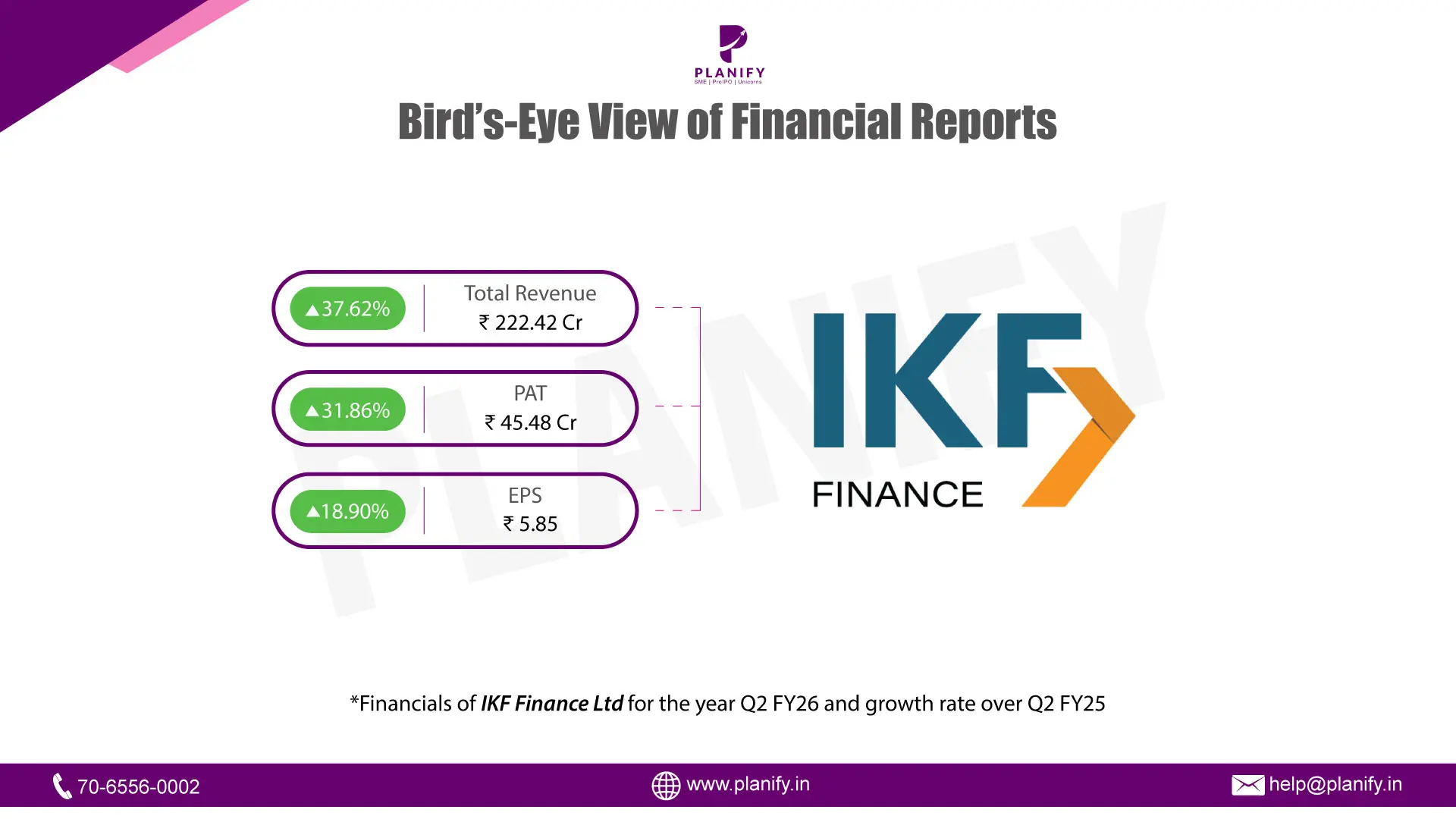
Date: Mon 22 Dec, 2025
- Financial Performance (Q2 FY26 vs Q2 FY25): HDFC Securities reported a weaker financial performance in Q2 FY26, with total revenue declining by 23.2% year-on-year (YoY) to ₹701 crore, compared to ₹913 crore in Q2 FY25. The decline was mainly due to lower fees and commission income along with losses on fair value changes during the quarter. Profit Before Tax (PBT) fell by 31.6% YoY to ₹282 crore from ₹412 crore in the same quarter last year. Profit After Tax (PAT) declined by 33.2% YoY to ₹211 crore, compared to ₹315 crore in Q2 FY25. Earnings Per Share (EPS) also declined by 33.8% YoY to ₹118.2, from ₹178.5 last year.
- Operational Metrics (Q2 FY26 vs Q2 FY25): Operational performance saw pressure on margins during the quarter. Operating margin declined to 40% in Q2 FY26 from 45% in Q2 FY25, while net profit margin reduced to 30% from 35% last year. The interest service coverage ratio stood at 2.9 times, slightly lower than 3.0 times in Q2 FY25, reflecting higher finance costs. The debt-to-equity ratio remained elevated at 3.39 times, while debtors turnover improved to 0.9 times from 0.8 times, indicating better collection efficiency.
- Strategic Developments: During the quarter, the company allotted 83,382 equity shares under employee stock option schemes and granted 17,250 stock options, continuing its focus on employee retention. HDFC Securities also declared and paid an interim dividend of ₹90 per share, reflecting confidence in cash flows despite near-term earnings pressure. The GIFT City subsidiary remains small and had no material impact on consolidated performance. The company’s net worth increased to ₹3,520.1 crore, up 10.9% YoY, providing a strong capital base. The financial performance during the quarter reflects prevailing capital market conditions, including lower trading activity and subdued investor participation. While near-term results remain linked to market sentiment, the company’s prudent risk management and stable client base support long-term sustainability.
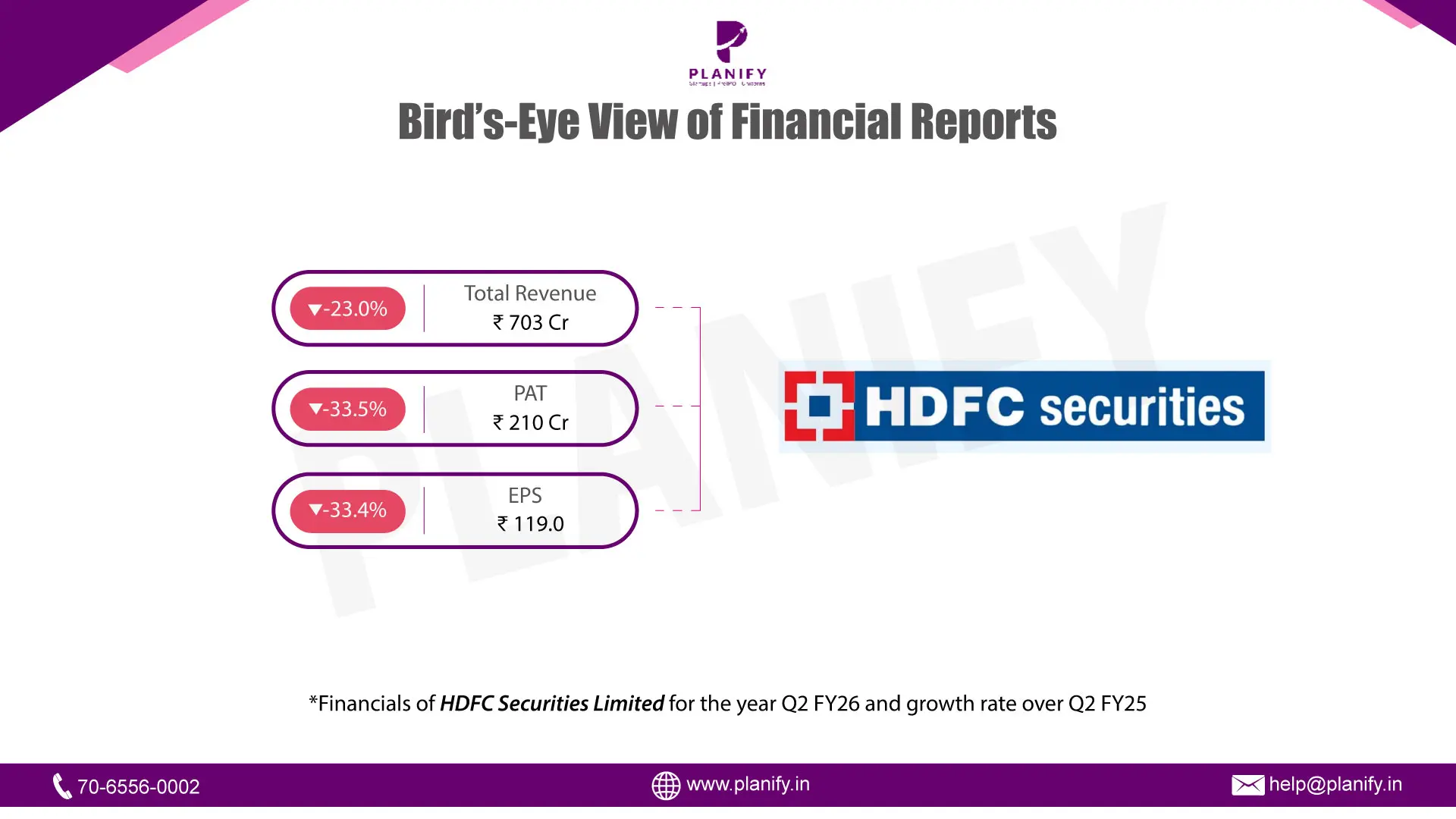
Date: Mon 22 Dec, 2025
Financial Performance(Q2 FY26 vs Q2 FY25): KLM Axiva Finvest reported a mixed financial performance in Q2 FY26, with total income increasing marginally by 10.82% year-on-year (YoY) to ₹89.61 crore, compared to ₹80.86 crore in Q2 FY25. The modest growth was primarily supported by stable interest income, while other income also contributed during the quarter. Profit After Tax (PAT) increased by 5.0% YoY to ₹6.2 crore, compared to ₹5.9 crore in Q2 FY25. Earnings Per Share (EPS) stood at ₹0.28, lower than ₹0.50 reported in the same quarter last year.
Operational Metrics (Q2 FY26 vs Q2 FY25): Operational performance during the quarter reflected pressure on profitability metrics. Operating margin declined to 4.2% in Q2 FY26 from 7.6% in Q2 FY25, while net profit margin moderated to 1.2% from 3.6% in the previous year. The interest service coverage ratio stood at 1.08 times, indicating tighter coverage compared to historical levels due to higher finance costs. The debt-to-equity ratio remained elevated at 5.4 times, reflecting the leveraged nature of the balance sheet.
Strategic Developments: Net worth stood at ₹291.1 crore as of September 2025, providing capital support for ongoing operations. The company continues to focus on its core lending activities, with no material changes in business segments or strategy during the quarter. Overall performance in Q2 FY26 reflects stable loan growth and asset quality, while profitability remained under pressure due to higher costs and leverage.
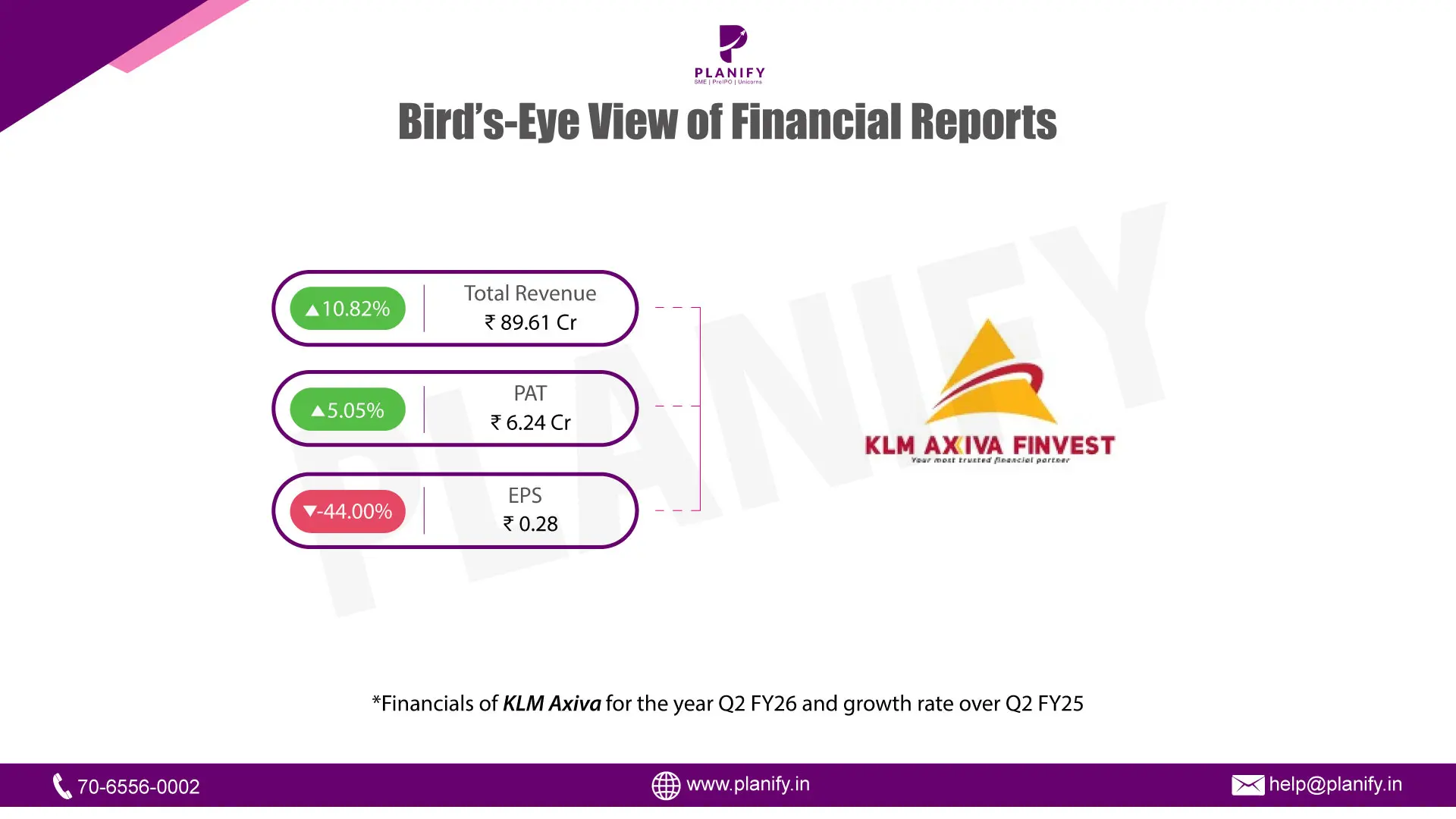
Date: Thu 18 Dec, 2025
For decades, Studds has been synonymous with affordable, mass-market helmets.
Studds Accessories Limited formally an Indian manufacturer of two-wheeler helmets and motorcycle accessories has been a dominant name in head protection for riders.
Founded in 1983 by the Khurana family, with Madhu Bhushan Khurana and Sidhartha Bhushan Khurana in leadership roles, Studds Accessories has spent nearly four decades building India’s largest helmet manufacturing business. The company’s portfolio spans full-face, open-face, flip-up helmets and a range of riding gear marketed under its own brand names: Studds and SMK.
From Mass to Premium: The Strategic Shift
India’s largest two-wheeler helmet maker is accelerating its shift up the value chain, aiming to double the share of premium helmets in its revenue mix over the next two years, a move that signals changing consumer behaviour as much as corporate strategy.
According to industry commentary and statements from the company’s Managing Director, Studds Accessories expects to double the revenue share of premium helmets from around 15.5% to ~30% within the next two years.
The backdrop is compelling. India remains the world’s largest two-wheeler market, but helmet consumption is evolving beyond basic compliance. Rising disposable incomes, stricter safety awareness, and aspirational buying especially among urban riders are pushing demand toward higher-priced, feature-rich helmets. Studds is positioning itself right at this intersection.
- Premium helmets, typically priced multiple times higher than entry-level models, offer structurally better margins. For Studds, this means profit growth can outpace volume growth, even if overall industry demand remains steady.
- The company has been expanding its premium portfolio with better ventilation systems, lighter materials, aerodynamic designs, and global safety certifications, features that appeal to both domestic riders and export markets.
- Exports are another quiet lever. Studds already has a strong overseas presence, and premium products improve competitiveness in developed markets where pricing power is higher and safety norms are tighter. As premium penetration rises, average realisation per helmet improves, reducing dependence on sheer volume-led growth.
Date: Wed 17 Dec, 2025
What began as a ₹75-lakh funding pitch on Shark Tank India has translated into tangible market gains for investors. Ravelcare, the personal-care brand that gained early visibility through the show, delivered a ~55% listing premium on its SME IPO turning a televised pitch into a real capital-market outcome.
About Ravelcare
Ravelcare began as a digital-first beauty and personal care brand founded in 2018 by Ayush Varma, offering personalised haircare, skincare, and bodycare products through its own website and major marketplaces like Amazon, Flipkart, and Myntra. Its early strategy combined data-driven formulation with direct-to-consumer engagement, a model that helped it carve out a niche in a highly competitive category.
Shark Tank India Spotlight
- Ravelcare appeared on Shark Tank India Season 2, where Ayush Varma pitched for ₹75 lakh for a 2.5% equity stake, valuing the business at around ₹30 crore. The show created a significant boost in brand awareness and online traction. In the episode, investor Anupam Mittal offered ₹75 lakh for a 10% stake, with the condition that the company hit projected numbers within two years.
- However, public records and reporting do not confirm any post-show deal actually closing on those terms. What the brand did gain from the exposure was elevated consumer recognition and stronger engagement, which helped bolster demand heading into its IPO.
RavelCare IPO Performance
The IPO drew exceptional investor interest, with overall subscription reaching 437.6 times, led by retail, NII, and QIB bids. Anchor investors had already committed ₹6.83 crore before the public bid opened.
On December 8, 2025, Ravelcare debuted on the BSE SME platform at around ₹201 per share, roughly a 55% premium above its ₹130 issue price, marking a rare and strong listing performance for an SME consumer brand.
The Shark Tank appearance served more as a brand catalyst than a traditional funding milestone. Its real value for investors lies in the company’s execution track record, retail traction, and how effectively it deploys capital toward deeper penetration, distribution, and manufacturing integration.
Date: Sun 14 Dec, 2025
Sun Drops Energia Private Limited, part of the KP Group and known for its presence in solar power EPC and clean-energy solutions has taken a major step toward scaling its corporate structure.
The company has formally called an Extraordinary General Meeting (EGM) on December 29, 2025, seeking shareholder approval to convert from a private limited company into a public limited company.
Sun Drops Energia Private Limited, the renewable energy arm of the KP Group’s KPI Green Energy platform, has strengthened its project pipeline by securing new contracts to develop solar power projects totaling 62.20 MW under the Captive Power Producer (CPP) segment. This order builds on Gujarat’s renewable energy push and expands the company’s operational footprint in the utility-scale solar sector.
- Under India’s Distributed Renewable Energy Bilateral Purchase (DREBP) Policy and the Gujarat Renewable Energy Policy-2023, Sun Drops Energia won Letters of Award from multiple clients to execute the projects, expected to be completed by FY 2025-26 in phased tranches.
- This 62.20 MW addition brings the unit’s CPP portfolio to 152.34 MW, underpinning a broader order book of 1.60 GW in captive solar commitments held by KPI Green Energy and its subsidiaries.
- Converting Sun Drops Energia into a public entity positions it to scale aggressively into solar, hybrid power, and emerging BESS opportunities.
With expanding project wins, a deeper order pipeline, and a planned IPO on the horizon, Sun Drops Energia is shaping up as KPI Green's next growth engine aiming to move from a fast-scaling subsidiary to a capital-powered renewable platform.
Stay Connected, Stay Informed –
Don’t miss out on exclusive updates, market trends, and real-time investment opportunities. Be the first to know about the latest unlisted stocks, IPO announcements, and curated Fact Sheets, delivered straight to your WhatsApp.